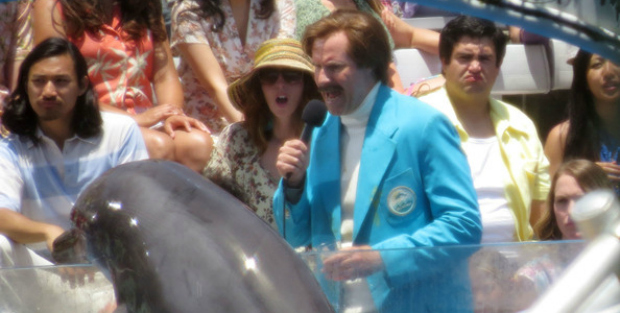
In the name of entertainment
What a night at the movies costs animal ‘actors’
People around the world are waking up to the fact that animals and entertainment just don’t mix. But some old habits die hard; yet another major Hollywood production has landed in hot water for using wild animals. Anchorman 2 stars Will Ferrell, Christina Applegate, and two dolphins from controversy-wracked SeaWorld. Lurking behind the Hollywood gloss and the dolphins’ permanently smiling appearances are dark secrets that the movie industry would prefer to remain hidden.
Animal Defenders International (ADI) works actively to expose the harm caused to all wild animals when used in film, advertisements and other entertainment industries. Dolphins, and their orca cousins who are also kept at SeaWorld, are intelligent, complex animals who suffer greatly in captivity which deprives them of the freedom and familial society they enjoy in the wild.
In Anchorman 2, two dolphins at SeaWorld San Diego perform an unnatural behaviour known as ‘tail-walking’, in which the dolphins hold their bodies vertically and ‘walk’ through the water using their tails. Although this may seem like harmless fun, these highly intelligent animals endure a lifetime of confinement, performance and cruelty. Early last year, video was released of a dolphin thrown from the tank during a SeaWorld show, seen bleeding from the tail onto the concrete floor whilst staff urge visitors to leave. Weeks before the incident, authorities had been asked to investigate a dolphin with a chunk of flesh missing from her lower jaw.

SeaWorld San Diego boasts that “these animals live in some of the largest and most advanced marine mammal habitats in the world”. Yet dolphins and orca can travel up to 100 miles in a single day in the wild, and confining them to comparatively tiny pools is a harsh restriction which greatly deprives the animals of their natural state. The unhealthy captive conditions weigh heavily on the animals – orcas live a mere 9 years on average in captivity, compared with 30-50 years in the wild, with some surviving to 90.
SeaWorld has been racked by controversy for many years, and the park is facing renewed and severe criticism following the release of Blackfish, a film following the tragic story of Tilikum, an orca who was taken from the wild and separated from his family. In captivity, he has been mercilessly bullied by his companions, used to breed from and forced to perform. Tilikum has been involved in the deaths of several people, and there are growing calls for his release.
Sadly, SeaWorld and Anchorman 2 are by no means unique in forcing animals to suffer in the name of entertainment. But luckily for the animals, they are not the only ones armed with cameras. Footage captured by ADI exposed the horrors faced by elephants during training. Undercover footage at Have Trunk Will Travel, a company providing elephants for Water For Elephants and Zookeeper, shows elephants chained and barely able to move for 12 hours a day, viciously hit and hooked in sensitive areas with heavy pointed bullhooks and shocked with stun guns during ‘training’.
Although some films such as Anchorman 2 display a ‘no animals were harmed’ statement from the American Humane Association, this can be deceptive. The Hollywood Reporter recently revealed widespread animal cruelty, neglect and death both on and off set at American Humane Association monitored films. The extensive list of incidents includes a tiger reported nearly drowned on the set of Life of Pi, horses gored and dogs punched repeatedly. During a hiatus in filming The Hobbit: An Unexpected Journey, 27 animals including goats and sheep died from dehydration, exhaustion or drowning.
Even in a scenario in which one could prevent animal suffering on set, a huge body of evidence amassed by undercover investigations, industry insiders turned campaigners and even a deathbed confession show that the majority of abuse happens to animals in entertainment during training and confinement.
Fortunately, Hollywood has captivatingly shown that there is no need for animals to suffer for the big screen, with Rise of the Planet of the Apes and upcoming Noah showcasing beautifully rendered CGI animals. Feature-length documentary Lion Ark charts the rescue of animals from a life of captivity and forced performance for circuses across Bolivia, offering an uplifting antidote to animal suffering in entertainment.
You can help animals in entertainment by refusing to watch movies that use unwilling animal ‘actors’ and supporting groups like ADI that campaign against the inherently cruel use of animals for entertainment.







COMMENTS